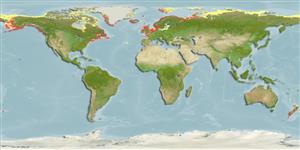Common names from other countries
Classification / Names / Names
Namen | Synonyme | Catalog of Fishes (gen., sp.) | ITIS | CoL | WoRMS
Environment: milieu / climate zone / depth range / distribution range
Ökologie
; brackwasser; tiefenbereich 1 - 182 m (Ref. 126559). Temperate
Arctic, Eastern Pacific, Northern Atlantic and the Mediterranean: Canadian Arctic Archipelago and British Isles.
Length at first maturity / Size / Gewicht / Alter
Maturity: Lm ? range ? - ? cm Max length : 2.0 cm WD Männchen/unbestimmt; (Ref. 3719)
Most commonly found in the subtidal zone, on the underside of smooth rocks, but very infrequently on highly brackish water. Individuals occur as fouling organisms on ship bottoms and docks, inside crab carapace, mussle shells, and plate limpets, also in bottles, wood, and kelp (Ref. 126559). Naupliar stage larvae are found in the water column and are flushed back into the sea with the fresh water outflow. Larvae migrate into estuaries at a later stage where they settle (Ref. 126559). Found in muddy substrates associated with organic pollutants (Ref. 96352) and on mixed sediments with gravel, pebbles and sand (Ref. 118257). This is an attached (Ref. 3123), epibenthic species (Ref. 95730). Suspension feeder (Ref. 118257). A microvore that feeds on organic detritus (Ref. 96352).
Life cycle and mating behavior
Geschlechtsreife | Fortpflanzung | Ablaichen | Eier | Fecundity | Larven
Members of the superorder Thoracica are mostly hermaphroditic. Broadcast spawners, fertilization occurs in the mantle cavity. Life cycle: Eggs hatch into planktonic nauplii and leave the mantle cavity. Afterwards, they undergo six naupliar instars succeded by nonfeeding cypris larva (settling stage) which later metamorphose into adults.
Organisation for Economic Co-operation and Development. 1963. (Ref. 3719)
IUCN Rote Liste Status (Ref. 130435)
CITES Status (Ref. 108899)
Not Evaluated
Not Evaluated
Nutzung durch Menschen
| FishSource |
Tools
Mehr Information
Alter/Größe
Wachstum
Länge-Gewicht
Länge-Länge
Morphologie
Larven
Dichte
Internet Quellen
Estimates based on models
Preferred temperature
(Ref.
115969): 4 - 12.8, mean 9.1 (based on 674 cells).
Verwundbarkeit
Low vulnerability (10 of 100).
Preiskategorie
Unknown.
